-
 The cooking showdown began at 9 a.m. at the Lyceum of the Philippines Culinary Institute in Intramuros, Manila. Twenty-eight participants were divided into three batches, with each participant given one hour to prepare the dish. When the hour is over, they each presented and explained their dish to the panel of judges.
The cooking showdown began at 9 a.m. at the Lyceum of the Philippines Culinary Institute in Intramuros, Manila. Twenty-eight participants were divided into three batches, with each participant given one hour to prepare the dish. When the hour is over, they each presented and explained their dish to the panel of judges.
-
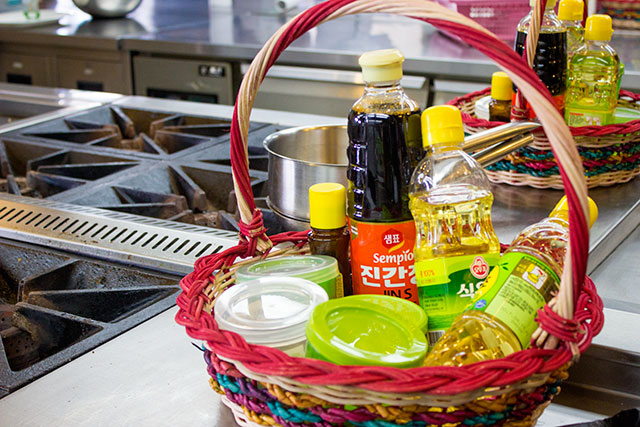 Korean seasonings provided by KCC Philippines were provided at each workstation.
Korean seasonings provided by KCC Philippines were provided at each workstation.
-
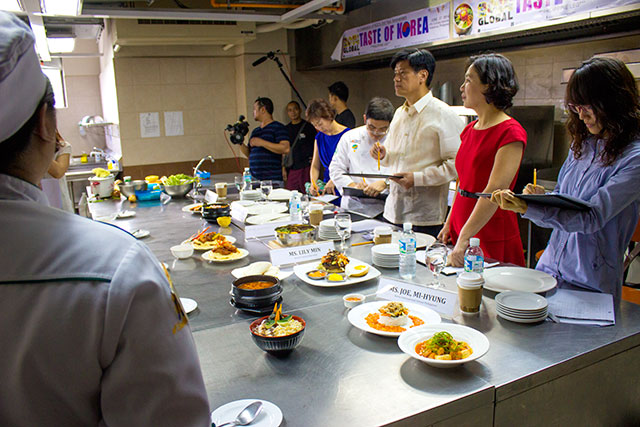 The panel of judges scores the dishes according to taste, presentation, and the contestants’ knowledge of and passion for Korean food.
The panel of judges scores the dishes according to taste, presentation, and the contestants’ knowledge of and passion for Korean food.
-
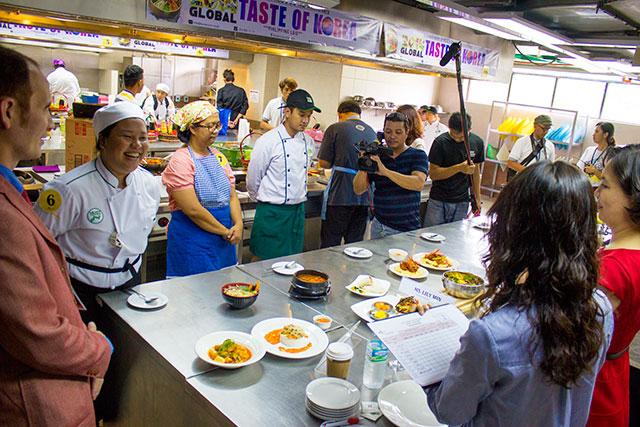 Even though some contestants found the interview nerve-wracking, there were still some light moments to be shared.
Even though some contestants found the interview nerve-wracking, there were still some light moments to be shared.
-
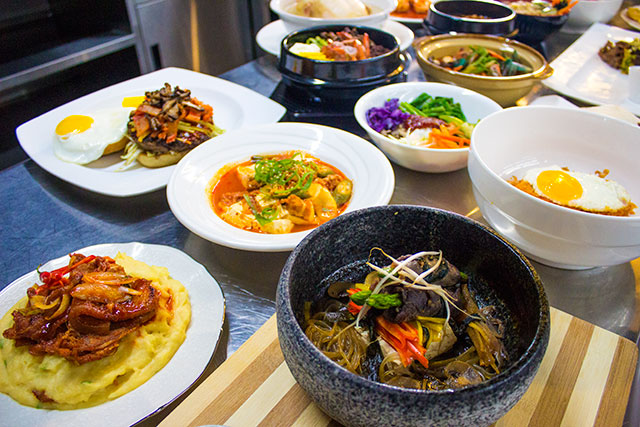 Korean food often have striking colors—according to custom, a dish’s nutritional value is judged by how many colors or flavors it has. The customary standard is five colors or five flavors, each representing the five elements of a healthy balanced diet.
Korean food often have striking colors—according to custom, a dish’s nutritional value is judged by how many colors or flavors it has. The customary standard is five colors or five flavors, each representing the five elements of a healthy balanced diet.
-
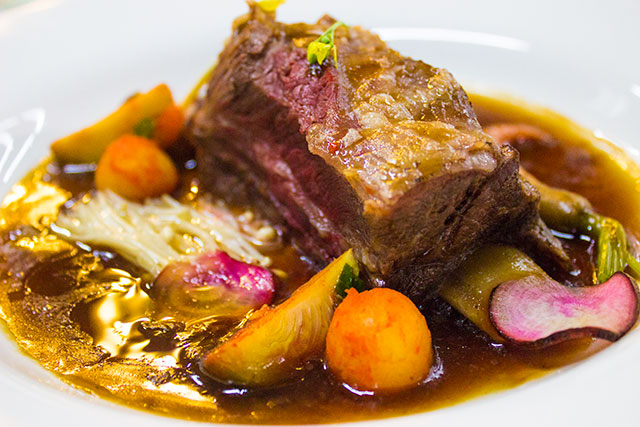 John Patrick Ignacio’s Galbi Jjim (braised beef shortribs) used European cooking techniques to improve the flavor of the beef, which he combined with roasted pumpkin, ube fondant, and mushrooms.
John Patrick Ignacio’s Galbi Jjim (braised beef shortribs) used European cooking techniques to improve the flavor of the beef, which he combined with roasted pumpkin, ube fondant, and mushrooms.
-
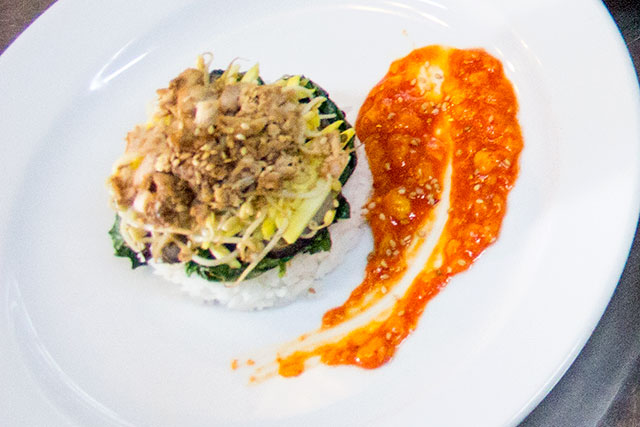 Kristina Yzabel Montealegre made two Pinoy-Korean fusion dishes. She added green mango to her Bibimbap and ripe mango to the gochujang sauce: a perfect balance of the yin and yang of Filipino sweet and sour flavors with Korean spicy and salty.
Kristina Yzabel Montealegre made two Pinoy-Korean fusion dishes. She added green mango to her Bibimbap and ripe mango to the gochujang sauce: a perfect balance of the yin and yang of Filipino sweet and sour flavors with Korean spicy and salty.
-
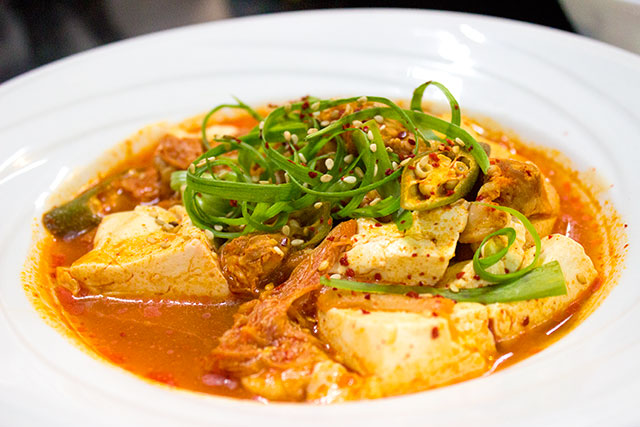 “Sini-gae” combined the tangy sinigang with the Korean Kimchi Jjigae. The combination of the two soups created an extraordinary flavor.
“Sini-gae” combined the tangy sinigang with the Korean Kimchi Jjigae. The combination of the two soups created an extraordinary flavor.
-
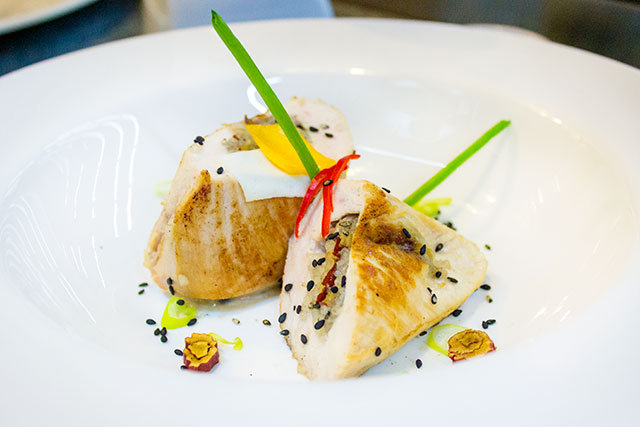 Marc Justin Tee took the grand prize by keeping it simple with his Samgyetang—chicken meat stuffed with glutinous rice and mixed with ginseng and Korean dates. The minimalist plating made it more presentable and the dish as a whole upheld the Korean food tradition of being both nourishing and healing.
Marc Justin Tee took the grand prize by keeping it simple with his Samgyetang—chicken meat stuffed with glutinous rice and mixed with ginseng and Korean dates. The minimalist plating made it more presentable and the dish as a whole upheld the Korean food tradition of being both nourishing and healing.
-
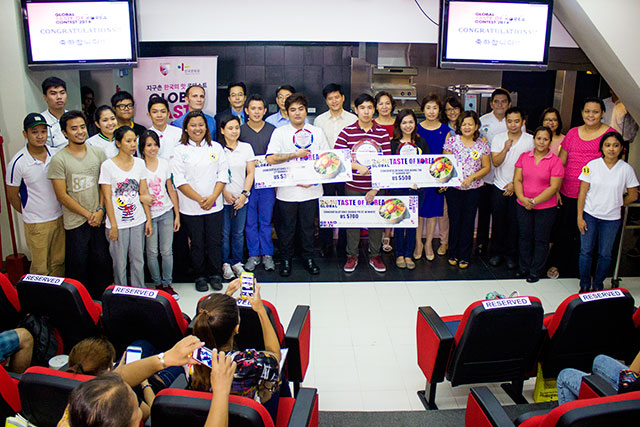 After the competition, the finalists of Taste of Korea posed for a group photo with Korean officials and Lyceum Culinary Institute administrators.
After the competition, the finalists of Taste of Korea posed for a group photo with Korean officials and Lyceum Culinary Institute administrators.
 The cooking showdown began at 9 a.m. at the Lyceum of the Philippines Culinary Institute in Intramuros, Manila. Twenty-eight participants were divided into three batches, with each participant given one hour to prepare the dish. When the hour is over, they each presented and explained their dish to the panel of judges.
The cooking showdown began at 9 a.m. at the Lyceum of the Philippines Culinary Institute in Intramuros, Manila. Twenty-eight participants were divided into three batches, with each participant given one hour to prepare the dish. When the hour is over, they each presented and explained their dish to the panel of judges.
 Korean seasonings provided by KCC Philippines were provided at each workstation.
Korean seasonings provided by KCC Philippines were provided at each workstation.
 The panel of judges scores the dishes according to taste, presentation, and the contestants’ knowledge of and passion for Korean food.
The panel of judges scores the dishes according to taste, presentation, and the contestants’ knowledge of and passion for Korean food.
 Even though some contestants found the interview nerve-wracking, there were still some light moments to be shared.
Even though some contestants found the interview nerve-wracking, there were still some light moments to be shared.
 Korean food often have striking colors—according to custom, a dish’s nutritional value is judged by how many colors or flavors it has. The customary standard is five colors or five flavors, each representing the five elements of a healthy balanced diet.
Korean food often have striking colors—according to custom, a dish’s nutritional value is judged by how many colors or flavors it has. The customary standard is five colors or five flavors, each representing the five elements of a healthy balanced diet.
 John Patrick Ignacio’s Galbi Jjim (braised beef shortribs) used European cooking techniques to improve the flavor of the beef, which he combined with roasted pumpkin, ube fondant, and mushrooms.
John Patrick Ignacio’s Galbi Jjim (braised beef shortribs) used European cooking techniques to improve the flavor of the beef, which he combined with roasted pumpkin, ube fondant, and mushrooms.
 Kristina Yzabel Montealegre made two Pinoy-Korean fusion dishes. She added green mango to her Bibimbap and ripe mango to the gochujang sauce: a perfect balance of the yin and yang of Filipino sweet and sour flavors with Korean spicy and salty.
Kristina Yzabel Montealegre made two Pinoy-Korean fusion dishes. She added green mango to her Bibimbap and ripe mango to the gochujang sauce: a perfect balance of the yin and yang of Filipino sweet and sour flavors with Korean spicy and salty.
 “Sini-gae” combined the tangy sinigang with the Korean Kimchi Jjigae. The combination of the two soups created an extraordinary flavor.
“Sini-gae” combined the tangy sinigang with the Korean Kimchi Jjigae. The combination of the two soups created an extraordinary flavor.
 Marc Justin Tee took the grand prize by keeping it simple with his Samgyetang—chicken meat stuffed with glutinous rice and mixed with ginseng and Korean dates. The minimalist plating made it more presentable and the dish as a whole upheld the Korean food tradition of being both nourishing and healing.
Marc Justin Tee took the grand prize by keeping it simple with his Samgyetang—chicken meat stuffed with glutinous rice and mixed with ginseng and Korean dates. The minimalist plating made it more presentable and the dish as a whole upheld the Korean food tradition of being both nourishing and healing.
 After the competition, the finalists of Taste of Korea posed for a group photo with Korean officials and Lyceum Culinary Institute administrators.
After the competition, the finalists of Taste of Korea posed for a group photo with Korean officials and Lyceum Culinary Institute administrators.